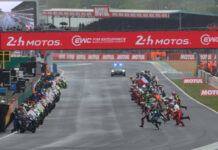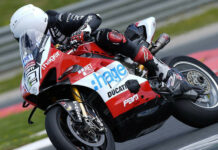To read more articles like this April 2016 column please subscribe to Roadracing World.
By Chris Ulrich
In February I learned that I was receiving the Hazel Kolb Brighter Image award from the American Motorcyclist Association (AMA). The award was for my work promoting motorcycle road racing and motorcycling in general by giving two-seat Superbike rides to reporters and broadcasters. The AMA also recognized my efforts using the two-seat Superbike program to raise money for the Roadracing World Action Fund (RWAF), a 501(3)(c) non-profit—a cause I am very passionate about.
Getting recognized for the work my family and I have done to promote the sport of motorcycle road racing over the years is awesome. I do the two-seat Superbike rides because I love motorcycle road racing and want to see it thrive in the United States. And I do fundraising for the RWAF to help improve safety at racetracks for the benefit of everyone who participates in races, track days, and track-based riding schools.
Motorcycle road racing is misunderstood and underexposed in the United States. Our sport, which is as exciting as any sport on the planet, constantly struggles to attract attention from the non-motorcycling media. We kept meeting reporters who just didn’t get it, so we decided to offer to put them on the back of a 1000cc racebike for a few laps with an actual, currently competing motorcycle racer. A few have decided not to ride after putting the leathers on; a few have tapped out before we reached 70 mph exiting pit lane; but the vast majority actually went for the ride. Seeing the typical response afterwards is amazing. They’ve got a lot more understanding of and respect for our sport after feeling the forces produced by the bike, and experiencing the speed and the adrenaline rush. But most importantly they realized that hard physical exertion and concentration are required to ride a racebike fast and we’re not just sitting there.
The two-seat program has consistently gotten reporters and broadcasters excited about upcoming races, and that excitement showed in their reports. Seeing an excited reporter on TV a few days before the race weekend starts can help get more spectators to show up at the races—and we all know that increased spectator counts helps the entire paddock. So I’ve made a big effort to work with the media and make the program available wherever we go, even if it means showing up at the track early.
The Roadracing World Action Fund has also been a great project to be involved in. My father started the movement in 2001, raising money to buy soft barriers to deploy at AMA Pro Superbike races and at events put on by other racing organizations. When he started, AMA Pro Racing had three sections of inflatable Airfence soft barriers, and no plans to get more. He figured out that hitting what is basically a pre-inflated airbag is a lot better than hitting an unpadded wall or a row of water-logged haybales, and decided to do something about it. He started with an editorial on roadracingworld.com announcing that he was buying a 30-foot section of inflatable Airfence and challenging the road racing community—other team owners, racers, businesses, family, friends, and fans—to contribute to the cause. Contributions came pouring in, and 20 sections (more than 500 linear feet) were deployed in time for the AMA National held at Road Atlanta just five weeks later.
(That same weekend my teammate Grant Lopez crashed in Turn 12 and hit a section of soft barrier instead of the concrete wall outside the corner. Lopez dislocated his shoulder, but lived to tell the tale.)
Two weeks later the RWAF had added another 15 soft barrier sections and deployed all 35 (about 900 linear feet) at Road America, AMA Pro started cooperating and we’ve never looked back. Donations for the fund really took off later that season when Aaron Yates went backwards and headfirst into a soft barrier deployed in front of an Armco barrier positioned just off the edge of the racing surface at Sonoma Raceway. Yates got up and walked away from what could have been a very serious crash.
Since 2001, the RWAF has helped save countless riders. I had my first experience hitting a section of Airfence—positioned in front of a tire wall and steel barrier—when I crashed at speed entering Turn One at Barber Motorsports Park during the 2014 AMA Pro National. I hit the soft barrier with my chest and head, but was able to get up and walk away. I knew that many of my fellow racers had hit Airfence sections and walked away, so I believed it worked. But having first-hand experience proved it.
My personal fundraising started when I decided to raise money for the RWAF and also to help my then-teammate Vincent Haskovec adjust to life in a wheelchair after he hit a wall and suffered a crippling spinal cord injury at Sonoma in 2005. I offered to give people rides for a donation during a Fastrack Riders event at Fontana. It was pretty low-key, and we didn’t do much to promote the event so I only had 25 riders over the weekend. Most of the passengers were family members or friends. I hadn’t planned to continue the fundraiser after 2005 and I certainly didn’t have any idea how to grow the event. I helped the RWAF and Vincent and got to share my sport with a few people so I was fine. But we gained some support after the people involved saw that first event come off without incident or problem and realized that I was serious about it.
For 2006, Fastrack Riders increased its involvement with extra trackside support and pre-event promotion, and organized a silent auction. Participation rose from 25 to 44 riders and our combined effort raised $8,000 for the RWAF. Momentum took over and participation in each event steadily rose until the 2013 weekend when I gave 89 rides covering 194 laps and about 445 miles over two days. Participation was slightly less in 2014 due to rainy weather on the Sunday. The 2015 (and 10th-annual) RWAF Fundraiser was cut to one day due to a scheduling conflict, but was still a success, with 37 rides, which brought my total ride count to 900—all without incident—and total money raised for the RWAF to $52,000.
I’m proud of what we have been able to accomplish on and off the racetrack over the years. It has required a lot of effort and behind the scenes support from my family and the staff at Roadracing World. I get to do the glamorous (and fun) job of giving rides and talking to the media, but arranging all of that stuff requires serious leg work. We rely on David Swarts to work with the racetracks and arrange the media rides prior to race weekends. He and my dad also help the media reps get geared up. It’s all hands on deck for the RWAF event in November. My younger sister Natalie handles all the paperwork and scheduling while my dad and Dave prep riders. We also bring a mechanic out to the event for tire swaps and refueling. And we rely heavily on Fastrack Riders to provide the track time and additional logistical help. Everyone does their part to keep the program running smoothly. I’m thankful to be part of a program that brings positive attention to motorcycle road racing while also helping to improve rider safety.
It is an honor to receive the Hazel Kolb Brighter Image Award from the AMA. But our work is not done. We need to continue to raise money to replace damaged soft barrier sections and deploy more new sections, for use at road races and track days and at flat-track races alike. And there are still more broadcasters and reporters to educate about road racing and motorcycling in general, and more positive attention to bring to our sport.
Around here, we all call it motorcycle racing evangelism. And I’m proud to be a part of it.
To donate to the Roadracing World Action Fund click here.
To read more articles like this April 2016 column please subscribe to Roadracing World.







